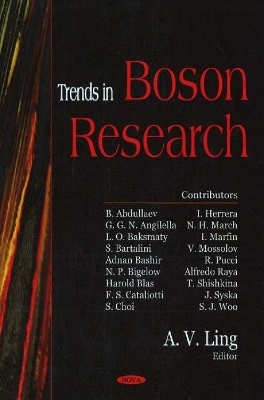
Trends in Boson Research
Seiten
2005
Nova Science Publishers Inc (Verlag)
978-1-59454-521-4 (ISBN)
Nova Science Publishers Inc (Verlag)
978-1-59454-521-4 (ISBN)
Bosons are particles which form totally-symmetric composite quantum states. As a result, they obey Bose-Einstein statistics. The spin-statistics theorem states that bosons have integer spin. Bosons are also the only particles which can occupy the same state as another. This book includes leading research from around the world.
Bosons are particles which form totally-symmetric composite quantum states. As a result, they obey Bose-Einstein statistics. The spin-statistics theorem states that bosons have integer spin. Bosons are also the only particles which can occupy the same state as another. All elementary particles are either bosons or fermions. Gauge bosons are elementary particles which act as the carriers of the fundamental forces such as the W vector bosons of the weak force, the gluons of the strong force, the photons of the electromagnetic force, and the graviton of the gravitational force. Particles composed of a number of other particles (such as protons or nuclei) can be either fermions or bosons, depending on their total spin. Hence, many nuclei are in fact bosons. While fermions obey the Pauli exclusion principle: "no more than one fermion can occupy a single quantum state", there is no exclusion property for bosons, which are free to (and indeed, other things being equal, tend to) crowd into the same quantum state. This explains the spectrum of black-body radiation and the operation of lasers, the properties of superfluid helium-4 and the possibility of bosons to form Bose-Einstein condensates, a particular state of matter. It is important to note that, Bose-Einstein condensation occurs only at ultralow temperature. There is nothing exotic about bosons otherwise. At any reasonable temperatures, both the boson and fermion particles behave as classical particles, i.e. particle in a box, and follow the Maxwell-Boltzmann Statistics. This new book includes leading research from around the world.
Bosons are particles which form totally-symmetric composite quantum states. As a result, they obey Bose-Einstein statistics. The spin-statistics theorem states that bosons have integer spin. Bosons are also the only particles which can occupy the same state as another. All elementary particles are either bosons or fermions. Gauge bosons are elementary particles which act as the carriers of the fundamental forces such as the W vector bosons of the weak force, the gluons of the strong force, the photons of the electromagnetic force, and the graviton of the gravitational force. Particles composed of a number of other particles (such as protons or nuclei) can be either fermions or bosons, depending on their total spin. Hence, many nuclei are in fact bosons. While fermions obey the Pauli exclusion principle: "no more than one fermion can occupy a single quantum state", there is no exclusion property for bosons, which are free to (and indeed, other things being equal, tend to) crowd into the same quantum state. This explains the spectrum of black-body radiation and the operation of lasers, the properties of superfluid helium-4 and the possibility of bosons to form Bose-Einstein condensates, a particular state of matter. It is important to note that, Bose-Einstein condensation occurs only at ultralow temperature. There is nothing exotic about bosons otherwise. At any reasonable temperatures, both the boson and fermion particles behave as classical particles, i.e. particle in a box, and follow the Maxwell-Boltzmann Statistics. This new book includes leading research from around the world.
Preface. Vortex Matter in Atomic Bose-Einstein Condesates; The Gross-Pitaevskii Equations and Beyond for Imhomogenous Condensed Bosons; Bosonisation, Soliton-Particle Duality and Mandelstam-Halpern Operators; Study of Anomalous Quartic Gauge Couplings at Gamma Colliders; Higgs Pair-Production at Next Generation Linear e+eI Colliders; Implicit Anyon or Single Particle Boson Mechanism of HTCS and Pseudogap Regime; Remarks on Self-Consistent Models of a Particle; Gauge Symmetry and its Implications for the Schwinger-Dyson Equations; Index.
| Zusatzinfo | Illustrations |
|---|---|
| Verlagsort | New York |
| Sprache | englisch |
| Maße | 260 x 180 mm |
| Gewicht | 740 g |
| Themenwelt | Naturwissenschaften ► Physik / Astronomie ► Hochenergiephysik / Teilchenphysik |
| ISBN-10 | 1-59454-521-9 / 1594545219 |
| ISBN-13 | 978-1-59454-521-4 / 9781594545214 |
| Zustand | Neuware |
| Haben Sie eine Frage zum Produkt? |
Mehr entdecken
aus dem Bereich
aus dem Bereich
The Biggest Ideas in the Universe
Buch | Hardcover (2024)
Dutton (Verlag)
CHF 36,15
Neue Sicht auf die Bausteine der Welt
Buch (2024)
Spektrum der Wissenschaft (Verlag)
CHF 13,70


